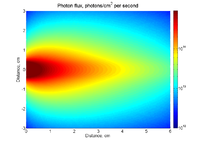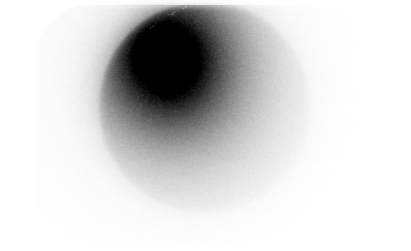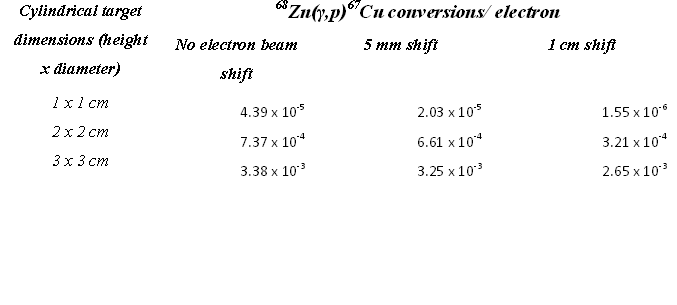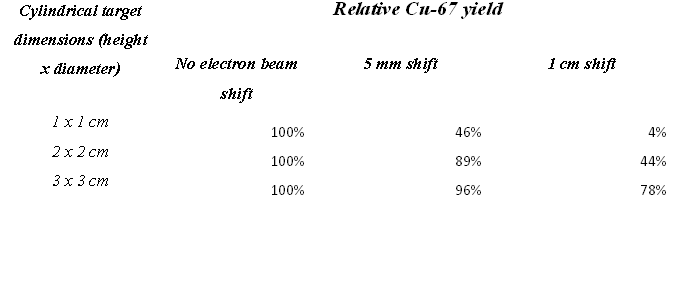Difference between revisions of "TF IsotopeTracers"
| Line 281: | Line 281: | ||
| − | |||
| − | |||
Cobalt-60, Lanthanum-140, Scandium-46, Silver-110m, Gold-198: | Cobalt-60, Lanthanum-140, Scandium-46, Silver-110m, Gold-198: | ||
Used together in blast furnaces to determine resident times and to quantify yields to measure the furnace performance. | Used together in blast furnaces to determine resident times and to quantify yields to measure the furnace performance. | ||
| − | |||
| − | |||
| − | |||
| − | |||
| − | |||
| − | |||
| − | |||
| − | |||
| − | |||
| − | |||
| − | |||
| − | |||
| − | |||
| − | |||
| − | |||
| − | |||
| − | |||
| − | |||
| − | |||
| − | |||
| − | |||
| − | |||
| Line 321: | Line 297: | ||
|Cesium-137|| ||Used for radiotracer technique for identification of sources of soil erosion and deposition, in density and fill height level switches. | |Cesium-137|| ||Used for radiotracer technique for identification of sources of soil erosion and deposition, in density and fill height level switches. | ||
|- | |- | ||
| − | | | + | |Chromium 57|| ||Used to label sand to study coastal erosion. |
| + | |- | ||
| + | |Cobalt-60 || || Used for gamma sterilisation, industrial radiography, density and fill height switches. | ||
| + | |- | ||
| + | | Gadolinium-148 || || | ||
| + | |- | ||
| + | | Gold-198 || || Used to study sewage and liquid waste movements, as well as tracing factory waste causing ocean pollution, and to trace sand movement in river beds and ocean floors. | ||
|- | |- | ||
| Iridium-192 ||<math>{193 \atop\; }Ir (\gamma,n){192 \atop \; }Ir</math> || Fracking ,Used in gamma radiography to locate flaws in metal components. | | Iridium-192 ||<math>{193 \atop\; }Ir (\gamma,n){192 \atop \; }Ir</math> || Fracking ,Used in gamma radiography to locate flaws in metal components. | ||
| Line 336: | Line 318: | ||
|- | |- | ||
| Strontium-90 || ||Used for industrial gauging | | Strontium-90 || ||Used for industrial gauging | ||
| + | |- | ||
| + | | Technetium-99m|| ||Used to study sewage and liquid waste movements, as well as tracing factory waste causing ocean pollution, and to trace sand movement in river beds and ocean floors. | ||
|- | |- | ||
|Thallium-204|| ||Used for industrial gauging. | |Thallium-204|| ||Used for industrial gauging. | ||
Revision as of 18:44, 4 February 2013
MRI RFP
http://www.nsf.gov/pubs/2013/nsf13517/nsf13517.htm
Highlights.
"MRI is not used to buy a suite of insturments to outfit research laboratories/facilities or be used to conduct independent research activities simultaneously".
"MRI is used for a single insturment or when combined serves as an integrated instrument."
The photon flux monitor when combined with the rabbit will be an instrument for both isotope production and PAA analysis research. The tool will have inter-disciplinary uses ranging from engineering to archeology.
- Track1
- Acquisition of a single instrument
- Track2
- development of a single instrument or for equipment that when combined serves as an integrated instrument.
We will be track 2. The combined equipment will be an integrated instrument for the production of Isotopes to be used in research and industry. The devise will also be an instrument for PAA analysis.
Proposal
The proposal will ask for a robot to move the sample from the trolley system into a pig because the holder may be activated as well as the sample.
A row of CVD detectors will be used to scan the photon field at low electron currents which will reduce the maximum photon flux to 10^9.
An array of CVD detector will be place downstream of the sample to monitor the flux as the electron current is increased to maximize the photon flux on the target. The position of the target can also be monitored with respect to the photon flux field as the field decreases to to the target absorbing photons.
Purpose
In June of 2012, the Idaho Accelerator Center received a grant from the state of Idaho as part of the Idaho Global Entrepreneurial Mission (IGEM) program. One of the proposed objectives was to research the use of an electron accelerator to produce Copper isotopes for medical diagnostic procedures. Preliminary results of the work sponsored by this research have indicated that the production of Copper isotopes strongly depends on the alignment of the incident radiation to the sample. While a two cm sample size may produce the highest number of isotopes per volume, a missalignment of more than a centimeter may reduce the amount of isotopes produced by a factor of at least two. A strong need now exists for a system to monitor the spatial distribution of the photons used to irradiate the samples. Based on these results, we propose the development of an irradiation instrument, that qualifies for the MRI category "Track 2", to be used for isotope production and PAA analysis.
The proposed instrument will be composed of a photon beam monitoring system and a sample conveyor. Support from this MRI will be used to construct the photon monitoring system. Matching support from the IGEM project will be used for the sample conveyor system. The conveyor, commonly referred to as a rabbit, will transport samples into the irradiation region and then to a shielded container (lead pig) after irradiation. The transportation system is a necessity due to the high activity isotopes that may be produced. When used as an instrument for PAA, the transportation system will eliminate the step of shutting the accelerator off in order to change to the control sample thereby risking a change in the experimental conditions whose uniformity is essential for meaningful measurements. Once calibrated, the photon monitoring system would allow users to irradiate sample with a known amount of radiation.
The proposed instruments ability to enhance the production of copper isotopes for medical diagnostic tests is only one potential use. Isotope production in the US is a $$$ busines..
Paragraph of the instruments impact on the production of isotopes.
Using the instrument for PAA and the large potential user base.
The University of Missouri's Research Reactor is a current producer of medical isotopes with a total operating budget o
Talking points
1.) The accelerator "Jack" is an instrument for PAA and isotope production
2.) Isotope production impact on other areas of research (medical, fracking, underground pipelines, spikants for homeland security)
3.) Inter organizational use of PAA ( Geology, Archeology, certification for coffee origins....)
4.) Impact of Photon Flux monitoring for PAA analysis
5.) Device will train accelerator physicists, nuclear chemists, ...
What is the difference between time-like and spacelike Feynman diagram
Minnesota Lunar Simulant
PAA was used to determine the trace elements present in the Minnessota Lunar Simulant 1 (MLS-1) material synthesized to approximate soil sample 10084 from the Apollo 11 mare material. Synthesized materials, like MLS-1, were produced to aide in the development of next generation lunar technologies for future lunar missions. Workshops were held to identify and define lunar regolith simulant materials for this purpose. Figure XXX quantifies PAA's ability to measure the trace elements of this material and contrasts those measurements with
In 2005, the Marshal Space Flight Center and the Johnson Space Center held a workshop to identify and define lunar regolith simulant materials that would be needed for the development of next generation lunar technologies to support future missions. This workshop was a follow up to a 1989 workshop that led to the development the lunar simulants MLS-1 and JSC-1. The PAA survey of this material was compared with Three moon dust simulant samples were irradiate for a PPA analysis and compared to a reference study.
[\ref L. Sibille, "Lunar Regolith Simulant Materials, Recommendations for Standardization, Production, and Usage", NASA TP, 2005]
http://isru.msfc.nasa.gov/lib/Documents/PDF%20Files/LRSM_docs/LRSM_Abstract_Book.pdf
Table 4.3B (pg 4-13) in the reference below has the trace element data for MLS-1 as attribute to Tucker and Setzer (1991) http://isru.msfc.nasa.gov/lib/Documents/PDF%20Files/Final_LSRM_Report_12-9-05.pdf
D. Tucker and A. Setzer, "Differential Thermal Analysis of Lunar Soil Simulant", NASA Technical Memorandum TM-103563, 1991
http://ntrs.nasa.gov/archive/nasa/casi.ntrs.nasa.gov/19920006733_1992006733.pdf
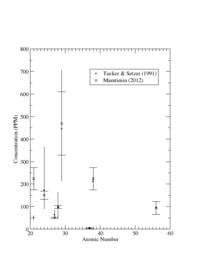 File:MLS-1 PAAresults.xmgrac.txt
File:MLS-1 PAAresults.xmgrac.txt
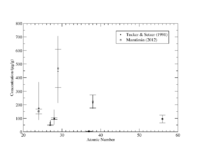
Budget
Equipment list
two steps
1.) purchase 16, single crystal detectors from http://www.npl.co.uk/upload/pdf/091104_nuc_galbiati.pdf. These will serve as monitors distributed symmetrically around the beam line and used to steer the electron beam until equal photon rates are observed => centered photon beam.
2.) A wire tungsten wire coated with diamond will sweep through the photon beam in the location of the target to measure the photon flux.
get http://www.npl.co.uk/upload/pdf/091104_nuc_galbiati.pdf to build a pixelated 3 x 3 cm detector with .5 x .5 cm size pixels (36 pixels)
OR if the photon flux is too high construct a wire array.
| Cost | Device | Purpose |
| 50,000 | BPMs | 4 electron beam position monitors |
| 20,000 | 16, CVD Diamond detector | Off the shelf single crystal single pixel detector pg 49 in[ http://www.npl.co.uk/upload/pdf/091104_nuc_galbiati.pdf] |
| 10,000 | 20 , 5 x 5 mm^2 CVD films | films for pixel detector array or wire (tungsten coated with diamond) scanner |
| 10,000 | Circuitry | PCB board, connectors, and single crystal mounting by external vendor |
| 30,000 | beam time | 3 weeks of beam time to test device and measure performance |
| $28,000 | DAQ | VME based DAQ system with EPICs monitoring, 32 channel ADC ($6k), ROC($3k), MiniCrate($4k), Server ($2k), Tigger supervisor ($3k), NIM Discriminator /Trigger/ECL output module ($10k) |
| $10k Cost Share | Beam Line components | Steering coils ($1k), power supplies ($4k), and Beam line components($5k) to install BPMs |
| $160k Cost Share | Rabbit | sample conveyor system from IGEM grant |
- Proposed Budget
- $148k + $160k (Cost share) = $308k
Equipment
Detectors
Erich Griesmayer
http://www.cividec.at http://www.cividec.at/#products.html
Prof. Dr. Erich Griesmayer CIVIDEC Instrumentation GmbH Schottengasse 3A/1/41 A - 1010 Wien Mobile: +43 664 1066840 Fax: +43 1 9223619 www.cividec.at
Element 6 office in Snata Clara, Ca
Thomas Obeloer. Thomas.Obeloer@e6.com
Simon Mathias; Element 6 UK office
Product Manager - Mechanical and New Applications
Element Six Technologies
Phone: + 44-1344 638209
Mobile: + 44-7557 995644
http://www.e6.com/
Technologies
Element Six Ltd., Kings Ride Park, Ascot, Berkshire, SL5 8BP, UK
BPMs
Bergoz Instrumentation:
S-BPM = $4080 Euros S-BPM-FEFA = $1260 Euros
the other accessories are also desired
File:Bergoz BPM PriceList 2012.pdf
Permanent magnet
Off the shelf
A M-25 5 kGauss permanent magnet with a footprint of 4" x 3" could be placed between the radiator and the isotope target on Jack.
http://www.mmr-tech.com/comp_electromagnets.php
The gap is 0.75" so it to would need to go in the vacuum. We would need to determine how much the beam spot blows up after leaving the converter and how high the photon flux is in the sample region after the 3" distance is taken up by the magnet.
Custom
The vendor below has stated that they have the ability to design a permanent magnet to our specification.
http://www.duramag.com/request-a-quote.html
The above vendor needs a CAD drawing showing the dimensions of a magnet that would work for isotope production on Jack in order to provide a quote.
Transport system samples
http://www.asi.com/auto-industrial/overhead-conveyors/monorail.php
References
Nitrogen tracers: N-15 is rare. If you dope nitrogen sources with it you can see where the leak into environment. This is a stable tracer so it would be able to monitor long time plume expansions.
Catchment hydrology
Review of Diamond detectors
http://www.ifh.de/~akg/phys/tapper.pdf
Simulations
http://www.osti.gov/energycitations/product.biblio.jsp?query_id=1&page=0&osti_id=20658046
High Flux MeV photon profiler
http://accelconf.web.cern.ch/accelconf/p99/PAPERS/WEA90.PDF
http://ieeexplore.ieee.org/ielx5/5379507/5398121/05398374.pdf?tp=&arnumber=5398374&isnumber=5398121
CVD Diamond film
Film Vendor only
http://www.e6cvd.com/cvd/page.jsp?pageid=415
Alemeda Applied Sciences Corporation
http://www.aasc.net/drds http://www.aasc.net/media/DRD-AppNote.pdf
Diamond x-ray view screen http://www.diamond-materials.com/EN/products/cvd_for_xray/fluorescence_beam_monitors.htm
http://www.npl.co.uk/upload/pdf/091104_nuc_galbiati.pdf
NIM paper from 2002
http://144.206.159.178/ft/787/47160/14168748.pdf
Diamond Detectors LtD (Vendor for single crystal Chip on Board Package)
http://www.npl.co.uk/upload/pdf/091104_nuc_galbiati.pdf
Medical isotopes
Market report forcasting -> 2015
2013 DOE Medical Isotope program budget and info
2010 Talk on Future Isotope needs in medicine and industry
http://www.nscl.msu.edu/~mantica/radio-frib/runde-acsboston.pdf
Need Mo-99, Tc-99m, I-131, I-125, Cu-67, At-211, Ac-225, Bi-213, Am-241, Gd-148, Sr-90, Pm-147
A big isotope supplier is Eckert & Ziegler
http://www.ezag.com/fileadmin/ezag/user-uploads/pdf/analyses-englisch/concord_e_01.pdf
2009 Medical Isotope industry & trade study
http://www.usitc.gov/publications/332/ITS-1.pdf
Fracking
http://www.shalegas.energy.gov/resources/111811_final_report.pdf
Earth Justice
http://earthjustice.org/features/campaigns/fracking-across-the-united-states
http://www.drillingmaps.com/fracking.html#.UQq-QKUlZ6I
Artificially-produced Isotope List
Jeff H. Shelton Isotope Business Office (IBO) National Isotope Development Center (NIDC) Telephone: (865) 576-6401 E-mail: EF6 or sheltonjh@ornl.gov
Cobalt-60, Lanthanum-140, Scandium-46, Silver-110m, Gold-198: Used together in blast furnaces to determine resident times and to quantify yields to measure the furnace performance.
Industrial
| Isotope | Production Reaction | Use |
| Am-241 | Used in backscatter gauges, smoke detectors, fill height detectors and in measuring ash content of coal. | |
| Cesium-137 | Used for radiotracer technique for identification of sources of soil erosion and deposition, in density and fill height level switches. | |
| Chromium 57 | Used to label sand to study coastal erosion. | |
| Cobalt-60 | Used for gamma sterilisation, industrial radiography, density and fill height switches. | |
| Gadolinium-148 | ||
| Gold-198 | Used to study sewage and liquid waste movements, as well as tracing factory waste causing ocean pollution, and to trace sand movement in river beds and ocean floors. | |
| Iridium-192 | Fracking ,Used in gamma radiography to locate flaws in metal components. | |
| Krypton-85 | Used for industrial gauging. | |
| Manganese-54 | Used to predict the behaviour of heavy metal components in effluents from mining waste water. | |
| Nickel-63 | Used in light sensors in cameras and plasma display, also electronic discharge prevention and in electron capture detectors for thickness gauges. | |
| Pm-147 | ||
| Selenium-75 | Used in gamma radiography and non-destructive testing. | |
| Strontium-90 | Used for industrial gauging | |
| Technetium-99m | Used to study sewage and liquid waste movements, as well as tracing factory waste causing ocean pollution, and to trace sand movement in river beds and ocean floors. | |
| Thallium-204 | Used for industrial gauging. | |
| Ytterbium-169 | Used in gamma radiography and non-destructive testing. | |
| Zinc-65 | Used to predict the behaviour of heavy metal components in effluents from mining waste water. |
Medical
Cesium-137 || || Used for radiotracer technique for identification of sources of soil erosion and deposition, in density and fill height level switches.| Isotope | Production Reaction | Use |
| Mo-99 | Medical | |
| Tc-99m | Medical | |
| Tl-201 | Medical Thalilum is most common substitute for Tc | |
| I-131 | ||
| I-125 | ||
| Cu-67 | ||
| Ac-225 | ||
| Bi-213 | ||
| Am-241 | Used in backscatter gauges, smoke detectors, fill height detectors and in measuring ash content of coal. | |
| Gd-148 | ||
| Sr-90 | ||
| Pm-147 | ||
| F-18 | Medical, aka FDG flourodeoxyglucose used in 90% of PET imaging | |
| Ga-67 | Medical | |
| Re -186 | Medical | |
| I-123 | Medical | |
| Sm -153 | Medical | |
| Y-90 | Medical | |
| Er-169 | Medical | |
| Y-88 | ||
| Sc-44 | ||
| Ir-192 | Fracking |
Vendors
Perkinelmer
http://www.perkinelmer.com/Catalog/Category/ID/Radionuclides
Isoflex
http://www.isoflex.com/isotopes/ir192.html
